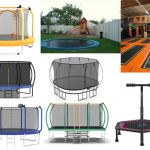- 1-Understanding-Nutritional-Needs-of-Trampoline-Athletes
- 2-Macronutrients-and-Their-Role-in-Performance
- 3-Hydration-Strategies-for-Optimal-Training
- 4-Timing-Your-Meals-for-Energy-and-Recovery
- 5-Supplements-and-Safe-Usage-for-Trampoline-Athletes
- 6-Real-Life-Case-Study-Nutrition-Impact-on-Performance
- 7-How-Trampoline-Zone-Supports-Athlete-Nutrition
1. Understanding Nutritional Needs of Trampoline Athletes
Trampoline athletes require a diet that supports explosive power, agility, and sustained endurance. Proper nutrition helps maintain muscle strength, improves focus, and accelerates recovery from intense training sessions. Unlike many other sports, trampoline demands quick bursts of energy combined with high coordination and balance.
1.1 Energy Demands and Metabolic Considerations
The sport’s intermittent high-intensity activity means athletes need both immediate energy sources and sustained fuel to avoid fatigue during routines.
1.2 Tailoring Nutrition to Training Phases
Nutritional needs shift between training, competition, and recovery days, requiring adaptable meal planning.
2. Macronutrients and Their Role in Performance
A balanced intake of carbohydrates, proteins, and fats forms the foundation of effective nutrition for trampoline athletes.
2.1 Carbohydrates for Quick Energy
Complex carbs like whole grains and fruits provide steady glucose release to fuel workouts and performances.
2.2 Protein for Muscle Repair and Growth
Lean proteins such as poultry, fish, and legumes support muscle recovery and adaptation post-training.
2.3 Healthy Fats for Sustained Endurance
Sources like nuts, seeds, and avocados supply essential fatty acids that aid in joint health and prolonged energy.
3. Hydration Strategies for Optimal Training
Staying properly hydrated enhances concentration, coordination, and physical output.
3.1 Importance of Pre- and Post-Training Hydration
Drinking water before sessions prevents early fatigue, while replenishing fluids after exercise aids recovery.
3.2 Electrolyte Balance
For longer or more intense training, electrolyte-rich drinks can maintain muscle function and prevent cramps.
4. Timing Your Meals for Energy and Recovery
When and what you eat affects your training quality and recovery speed.
4.1 Pre-Workout Nutrition
Consuming a light, carb-focused snack about 30-60 minutes before training helps sustain energy without causing discomfort.
4.2 Post-Workout Recovery Meals
Within an hour post-exercise, combining carbs and protein replenishes glycogen stores and repairs muscle tissue.
5. Supplements and Safe Usage for Trampoline Athletes
While whole foods are primary, some supplements may support nutrition gaps or enhance performance safely.
5.1 Common Supplements
Options like whey protein, omega-3 fatty acids, and multivitamins are popular among athletes.
5.2 Consulting Professionals
Before adding supplements, athletes should seek guidance to avoid banned substances and adverse effects.
6. Real-Life Case Study: Nutrition Impact on Performance
A trampoline athlete improved competition results after adopting a nutrition plan focusing on balanced meals and hydration. Enhanced energy levels and quicker recovery contributed to more consistent training and fewer injuries.
6.1 Insights from the Athlete
They emphasized how small adjustments in diet made a significant difference in focus and stamina during routines.
7. How Trampoline Zone Supports Athlete Nutrition
Trampoline Zone provides tailored nutritional resources and expert advice to help athletes fuel their training effectively.
7.1 Access to Expert Guidance
Athletes can connect with nutritionists familiar with trampoline demands for personalized plans.
7.2 Nutritional Products and Recommendations
The platform offers trusted supplements and meal ideas that align with trampoline athletes’ unique needs.
Optimizing nutrition is essential for trampoline athletes striving for peak performance. With these nutrition tips and support from Trampoline Zone, athletes can fuel their passion and reach new heights in their sport.







 Urban Air Trampoline and Adventure Park4.0 (696 reviews)
Urban Air Trampoline and Adventure Park4.0 (696 reviews) Hayden's International Gymnastics Academy4.0 (35 reviews)
Hayden's International Gymnastics Academy4.0 (35 reviews) Get Air Trampoline Park4.0 (575 reviews)
Get Air Trampoline Park4.0 (575 reviews) Cutie Patooties Play cafe5.0 (20 reviews)
Cutie Patooties Play cafe5.0 (20 reviews) Altitude Trampoline Park4.0 (370 reviews)
Altitude Trampoline Park4.0 (370 reviews) AGC LAS VEGAS4.0 (59 reviews)
AGC LAS VEGAS4.0 (59 reviews) Are Trampoline Parks Safe for Kids? Essential Guide for U.S. Parents
Are Trampoline Parks Safe for Kids? Essential Guide for U.S. Parents How Often Should You Replace Trampoline Springs? Tips for Proper Maintenance
How Often Should You Replace Trampoline Springs? Tips for Proper Maintenance How Much Is a Trampoline? A Detailed Guide to Trampoline Costs and Buying Tips
How Much Is a Trampoline? A Detailed Guide to Trampoline Costs and Buying Tips Bounce Techniques for Stronger Legs: Effective Exercises and Tips
Bounce Techniques for Stronger Legs: Effective Exercises and Tips Essential Music Gear for Trampoline Dance: Complete Guide
Essential Music Gear for Trampoline Dance: Complete Guide Fun STEM Experiments Using Trampolines to Spark Curiosity and Learning
Fun STEM Experiments Using Trampolines to Spark Curiosity and Learning